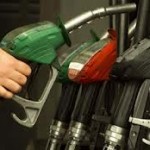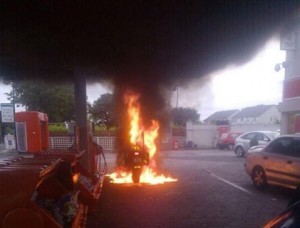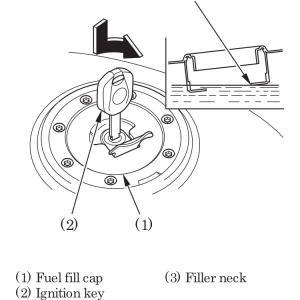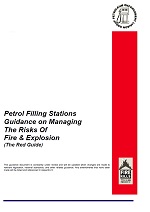 Back in July 2012, we reported that we were seeking clarification on forecourt rules after a number of riders told us they were refused petrol unless they dismounted. You can find that post here.
Back in July 2012, we reported that we were seeking clarification on forecourt rules after a number of riders told us they were refused petrol unless they dismounted. You can find that post here.
It’s taken longer than we’d have liked to get back to this topic, so better late than never, here’s what we learned.
We first asked the HSA (Health and Safety Authority) to clarify, and they said that they do not have a policy which requires riders to dismount before filling up, but they did refer us to to a guidance document published by the Petroleum Enforcement Liaison Group (PELG) in the UK (click here for PELG website).
Known as “The Red Guide” its official title is “Petrol Filling Stations Guidance on Managing The Risks Of Fire & Explosion”, and Page 71 says that to ensure petrol is dispensed safely:
“motor cyclists and their passengers should dismount from their machines”
So we asked PELG for clarification, and subsequently received a number of documents from them.
To summarise, PELG say that site operators/licensees have certain duties under the Health and Safety legislation which requires them to minimise the risks to the health and safety of persons on their premises and of the ignition of explosive atmospheres.
They went on to say:
“There are many recorded of cases of fires having occurred due to the overfilling of motor cycle and scooter tanks. Due to the close proximity of the tanks to hot engine parts and associated electrics, petrol vapour has been ignited either immediately the tank has been overfilled, or when the motorcycle is being restarted.
The reason for the overfilling can be associated with the fact that the filling of motor cycle fuel tanks is directly into the tank and not via a fill pipe as with a car, having the nozzle placed into the fill pipe of a car enables the cut off mechanism to operate before the fuel reaches a level where it will be spilt, this is not always possible with the tank of a motor cycle, particularly when the customer is trying to top up the tank, or during times when petrol has been adapted for winter temperatures, and the fuel is more volatile.
In view of the above, and to also avoid the contamination of customers clothing with petrol, the guidance to the operators of petrol filling stations is to not permit the filling of motor cycles or scooters whilst the rider or any passengers are sitting on them.”
PELG have provided substantial evidence to back up this position including the published advice of several major motorcycle manufacturers which advises filling the motorcycle while dismounted.

Image Credit: Facebook/Biker.ie
Accordingly, PELG members may continue to request that riders dismount before refueling, notwithstanding the difficulties this poses for riders of bikes fitted only with side stands.
We in MAG Ireland extend our thanks to PELG for the effort they put into engaging with us on this issue.
Associated links and documents:
Ducati Manuals: http://www.ducati.com/services/maintenance/index.do
BMW Manuals: http://www.bmw-motorrad.com/com/en/services/manuals/manuals_main.html
Honda Manuals: http://www.honda.co.jp/ownersmanual/HondaMotorEurope/motor/
Yamaha Manuals: http://www.yamaha-motor.eu/eu/services/owner-manuals/index.aspx
BMW Manuals (for example) note:
-
Fuel expands when hot.
-
Fuel escaping from an overfilled tank could make its way onto the rear tyre. This could cause a fall.
One piece of advice which appears in nearly all manufacturers manuals is:
Do not fill the tank past the bottom edge of the filler neck
The manual for the 2010 Honda CBR600RR, for example, includes an image clearly showing the bike on it’s side-stand (again, with advice not to fill beyond the bottom of the filler neck)

Image credit: Honda
